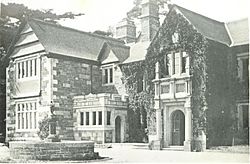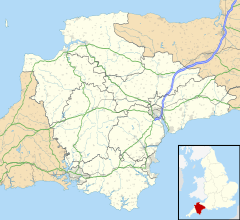Lewtrenchard facts for kids
Quick facts for kids Lewtrenchard |
|
|---|---|
 |
|
| Population | (2001 UK Census) |
| Civil parish |
|
| District |
|
| Shire county | |
| Region | |
| Country | England |
| Sovereign state | United Kingdom |
| Post town | Okehampton |
| Postcode district | EX20 |
| Police | Devon and Cornwall |
| Fire | Devon and Somerset |
| Ambulance | South Western |
| EU Parliament | South West England |
Lewtrenchard is a small village in Devon, England. The nearby village of Lewdown is also part of this area. Its name comes from an old record called the Domesday Book from 1086. There are also two rivers nearby called Lew. The "Trenchard" part comes from a family who owned the land a long time ago, in the 13th century.
Contents
Lew House: A Historic Home
Lew House, also known as Lewtrenchard Manor, was built around 1620. A famous person named Sabine Baring-Gould changed it a lot. He lived there for many years. In 1872, he took over his family's large estate. It was about 3,000 acres of land.
Sabine Baring-Gould was a priest. When the local church job became open in 1881, he became the parson (church leader) for Lewtrenchard. He also owned the land, so he was the squire. He worked hard to fix up both St. Peter's Church and his home, Lew House. Today, Lew House is a hotel, kept much like he rebuilt it.
St. Peter's Parish Church
The Parish Church of St. Peter is an interesting old building. It was first named after St Petroc. The top part of its tower is made of granite. Inside, you can see many old wooden benchends. These are like the ones found in churches in Cornwall.
Sabine Baring-Gould brought these benchends back to their original spots. He removed newer, plain wooden pews. The church has monuments from the 1600s, 1700s, and 1800s. These honor many members of the Gould and Baring-Gould families. There is also a painting called "Adoration of the Magi."
A very impressive rood screen stands in the church. It was carved by the Pinwill sisters. This screen was designed to look like one from the 1500s. It has 23 paintings on it. Sabine Baring-Gould's daughter, Margaret, painted them. Eleven paintings show scenes from the life of Jesus. The other twelve show saints from the Westcountry. This beautiful screen was finished in 1915.
The Battle of Gafulford
Galford, which is near Lewdown, might be where the Battle of Gafulford happened. This battle took place in the 800s. The Anglo-Saxon Chronicle is an old record. It says that in 825, a battle was fought. It involved the "West Welsh" (people from Cornwall) and the "Defnas" (people from Devon).
The record says: "The Westwealas (Cornish) and the Defnas (men of Devon) fought at Gafulforda." But it does not say who won or lost. It also doesn't say if the Cornish and Devon people were fighting each other. Or if they were fighting on the same side. The local vicar, Sabine Baring-Gould, was the first to suggest Galford as the battle site. He thought the name meant "a strong road." Others think it means "tax ford." Some people believe the battle happened at Camelford, which is further west.
Notable People from Lewtrenchard
Lewtrenchard and Lewdown have been home to some interesting people:
- Sabine Baring-Gould (1834–1924): He was an Anglican priest and wrote many hymns. He also owned land and was interested in old things.
- Lily Chitty (1893–1979): She was an archaeologist, someone who studies old human history. She was born in Lewdown.
- Jethro (1948–2021): He was a popular comedian from the West Country. He lived in Lewdown.
In the 1500s, Thomas Wood of Lew Trenchard built a large house. It was in Trevillet, Tintagel, in Cornwall. His son, John, later became a member of Parliament. He served in the government in 1614 and 1621–22.



